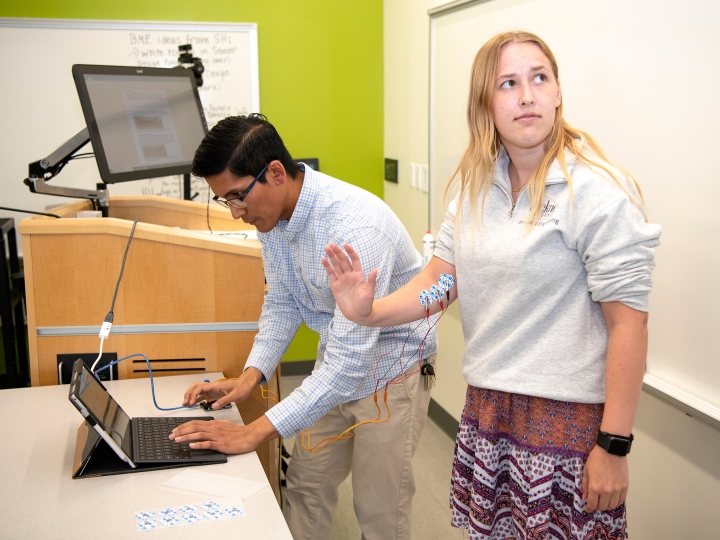Student-designed Computer System Could Lead to Safer Surgery
March 21, 2017
In the operating room, physicians and nurses perform a delicate balancing act. As a patient's vital signs rise and fall, anesthesia staff respond with drugs and other therapies to maintain stability and safety. As hours pass and complications arise, fatigue can take its toll on even the most skilled caregiver, increasing the risk of avoidable errors.
A group of Bucknell University student researchers led by Professor Philip Asare, electrical & computer engineering, in collaboration with Villanova University, the Department of Perioperative Medicine in the Clinical Center at the National Institutes of Health and the Geisinger Health System, is seeking to increase patient safety in the OR by easing the cognitive burden on anesthesiology teams. The engineering students have developed a prototype computer system that allows some of the many monitors, pumps and other systems used in the OR to communicate with each other and automatically respond to changes in a patient's vital signs.
"Let's say the patient monitor is sensing heartbeat and blood pressure. If there's a sudden change in blood pressure, the system is going to see that change," explained Win Kyaw '19, an electrical engineering major who has been working on the project since last summer. "When it drops below a certain limit that we've programmed, the system will change the function of the IV pump to either pump medicine faster or stop the infusion and then alert the doctor if necessary."
Late last semester, the group unveiled an early prototype of this potentially revolutionary system at a conference hosted by the Institute of Electrical and Electronics Engineers, the world's largest association of tech-industry professionals.
The AI system collects data from the medical devices that would be attached to a patient in the operating room and uses that information to tell other devices what to do. It can currently communicate with a patient monitor and IV pump and issue directions to the pump based on heart rate. The team plans to eventually refine the system to make decisions based on multiple variables (including blood oxygen saturation, pulse rate and blood pressure) and connect it to sensors that capture information not checked by the patient montitor. (Because it hasn't been approved for human testing, the students are using a patient simulator to test the system.)
While some medical devices made by the same manufacturer can be networked to communicate with each other, the researchers are building a universal system that can talk to any medical device. And no system currently approved for use in the U.S. can automatically issue orders to devices the way the Bucknell team's can, Asare said.
Asare notes that the system is not a replacement for medical staff, but a way to ease the cognitive burden on caregivers working in a stressful environment.
"In the operating room, physicians run all of this," he explained. "They're looking at multiple screens and making adjustments, over and over again for hours at a time. And as complications arise, there are more and more things that they have to keep track of. Automation reduces the burden and allows them to concentrate on the important stuff and work with the system to get the job done. And that increases patient safety."
A Multi-institution Collaboration
To ensure the system is of beneficial use to physicians, the team is collaborating with anesthesiologists and other staff at the nearby headquarters of the Geisinger Health System, a leading regional healthcare network and research institution. This part of the work has been supported by a Bucknell-Geisinger Research Initiative grant since January 2016.
"They've given us a lot of feedback about what we've done so far, the types of user interfaces that they want to see in the long run and the need that our project is moving toward filling," said Caitlin Mahoney '19, a markets, innovation & design major who has been working on the project since fall 2015.
A separate team at Villanova is programming a set of patient simulation models that will help the team more accurately test the system and Bucknell Computer Science Professor Evan Peck, an expert in human-computer interaction, recently joined the project to help develop the system's user interactions.
"Some of the artificial intelligence development has to do with what happens if something goes wrong," Asare explained. "If you lose the network connection, what should the pump do to keep the patient alive until you resolve those issues? That's what Evan is starting to work with us on."
Asare is seeking a grant from the National Science Foundation to further the project and is also interested in applying for a scholar-in-residence fellowship at the Food and Drug Administration in order to better navigate the complex challenges of gaining FDA approval for the system. While some companies have been granted approval for operating-room technology with some limited networking capability (but not automation), gaining approval for a universal system like the Bucknell team's requires proving the system can work with all products currently on the market — a daunting task. And while researchers have experimented with similar systems in Europe, medical device manufacturers in the U.S. will not try to implement the technology unless they see a clear path to FDA approval, Asare noted.
"We're hoping this can be a case study," Asare said. "So if a company develops one of these devices in a couple of years, they'll be a path to approval for them to follow."
To further encourage adoption of the system, the team is using open-source code, which it will offer for others to use and improve freely.
"It's something that can be used widely in hospitals all over the U.S.," said Dikendra Karki '19, an electrical engineering major and member of the research team for two years. "It can possibly save a lot of lives in conditions that are sometimes fatal. That's the thing that excites me the most."

